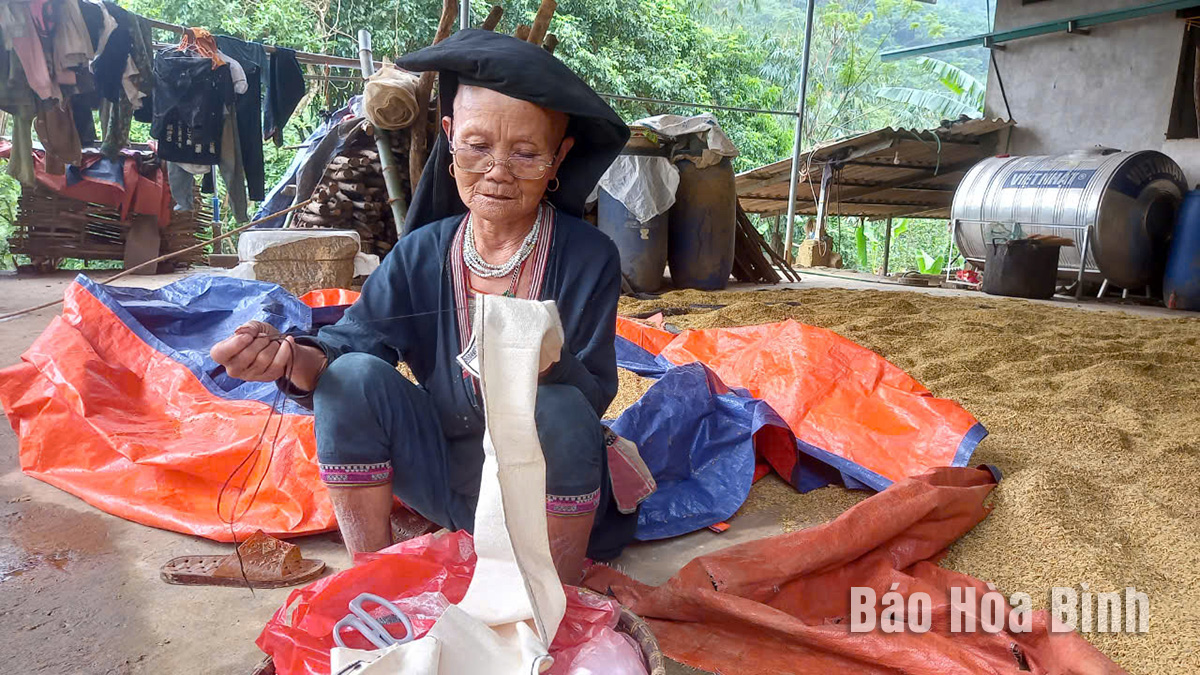
Suoi Ben is a remote village located about 40km away from Luong Son town, bordering Kim Boi district, with the majority of its households being Dao.
Phung Thi Thanh, who resides in Suoi Ben village, Lien Son commune, Luong Son district still preserves the traditional embroidery of Dao ethnic people.
A new cultural house was built in Suoi Ben village last year with funding from the National Target Programme for Socio-Economic Development in Ethnic Minority and Mountainous Areas. Covering an area of 180 sq.m, the project had a total investment of 1.3 billion VND (about 52,900 USD). Of which, 1.1 billion VND came from the State budget and the rest was raised among the community through labour contribution.
Duong Tai Phu, secretary of the village’s party cell said the village is home to 70 households with a population of 300. The main source of income for local residents comes from forest and agricultural production. Previously, its cultural house was too small, so village meetings or community activities had to be held at the village chief’s house or those with larger houses. This inconvenience made it difficult to carry out many tasks, especially the dissemination of the policies and guidelines of the Party and the State, which require gathering people in one place.
Dinh Manh Dong, an official of the Ethnic Affairs Division of Luong Son district, said as a district that has been recognised as meeting new-style rural standards, Luong Son prioritises investment in the most disadvantaged villages. Suoi Ben villagers contributed workday to build a new cultural house, along with support from the State budget, he said, elaborated that it was put into use in November last year, creating favourable conditions for community activities.
Duong Tai Chinh, a local resident, said that since the cultural house was put into use, it has hosted numerous cultural and sports events, along with meetings and dissemination campaigns to raise legal awareness among ethnic minority people, thus contributing to strengthening community bond. It also serves as a playground for children in the village to organise recreation activities, he added.
The secretary of the village’s party cell said that thanks to the new cultural house, organisation of community activities has become more convenient, therefore fostering connection among residents and encouraging them to actively pursue socio-economic development and sustainable poverty reduction.
With an increasingly vibrant and widespread emulation movement aimed at building cultured residential areas and cultured families, Yen Thuy District has been making steady progress toward improving both the material and spiritual well-being of its people, while fostering a civilized, prosperous, beautiful, and progressive community.
Once lacking recreational spaces and community facilities, Residential Group 2 in Quynh Lam Ward (Hoa Binh City) has recently received attention for the construction of a new, spacious, and fully equipped cultural house. The project followed the model of state support combined with public contributions in both labor and funding.
The "All people unite to build cultural life" movement, which has been effectively integrated with Kim Boi district’s socio-economic development goals, is fostering a lively spirit of emulation across local residential areas, hamlets, villages, public agencies, and enterprises. In addition, through the initiative, traditional cultural values are being preserved and promoted, while community solidarity and mutual support in poverty reduction and economic development are being strengthened.
A working delegation of the Hoa Binh provincial People’s Committee led by its Permanent Vice Chairman Nguyen Van Toan on June 11 inspected the progress of a project to build the Mo Muong Cultural Heritage Conservation Space linked to tourism services in Hop Phong commune, Cao Phong district.
Born and growing in the heroic land of Muong Dong, Dinh Thi Kieu Dung, a resident in Bo town of Kim Boi district, in her childhood was nurtured by the sweet lullabies of her grandmother and mother. These melodies deeply imprinted on her soul, becoming an inseparable part of her love for her ethnic group's culture. For over 20 years, this love for her hometown has driven Dung to research, collect, and pass down the cultural values of the Muong people to future generations.
In the final days of May, the Ethnic Art Troupe of Hoa Binh Province organized performances to serve the people in remote, mountainous, and particularly disadvantaged areas within the province. These were not just ordinary artistic shows, but they were the meaningful journeys aimed at spreading cultural values, enhancing the spiritual life of the people and contributing to the preservation of ethnic minority cultural identities.



